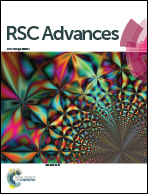An efficient mesoporous carbon nitride (g-C3N4) functionalized Pd catalyst for carbon–carbon bond formation reactions†
Abstract
Metal nanoparticles in pristine form without any stabilizing agents and free from agglomeration are very critical for their function and diverse catalytic applications. With the goal to accomplish a molecularly defined Pd-based heterogeneous C–C bond forming catalyst, highly ordered mesoporous nitrogen-rich carbon nitride (MCN) polymers with extended three-dimensional π-conjugation have been used as solid supports. Here, palladium nanoparticles ca. Pd(II) and Pd(0) were dispersed onto MCN and used in a surface-exposed state that renders them with inherently high catalytic activity. The catalysts were thoroughly investigated by a series of characterization techniques such as small-angle XRD, TEM, EDAX, SEM, 13C MAS NMR, 1H NMR, FTIR, N2 sorption, and CHN analyses. The XRD, N2 sorption isotherms and TEM show that Pd-catalysts maintain a hexagonal mesoporous structure with a high surface area (355.9 m2 g−1) and pore volume of 0.63 mL g−1. 13C MAS NMR and FTIR spectroscopy confirmed the presence of triazine ring, NH2 and NH groups in the polymeric graphitic carbon nitrides. Both Pd(II) and Pd(0) catalysts exhibited good catalytic activities and product selectivities in the copper- and phosphine-free Sonogashira cross-coupling reaction between aryl iodide and aryl alkynes. Hot filtration tests confirmed the heterogeneity of the catalysts and the catalysts were reused for six successive reactions with negligible change in the conversion.


 Please wait while we load your content...
Please wait while we load your content...